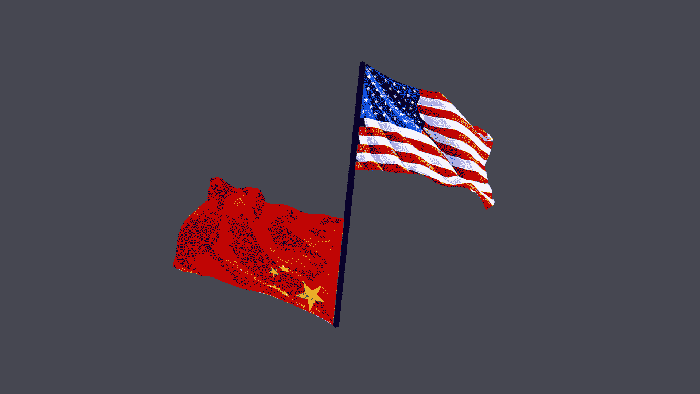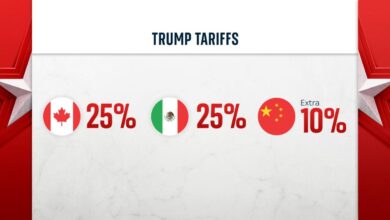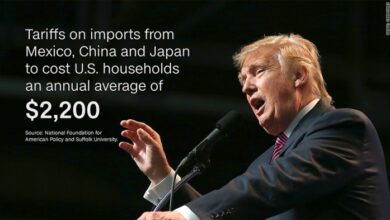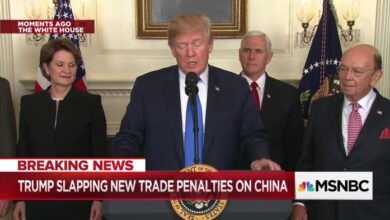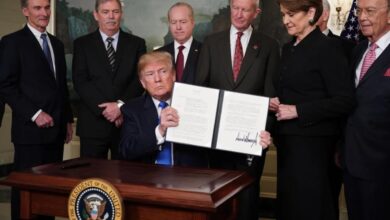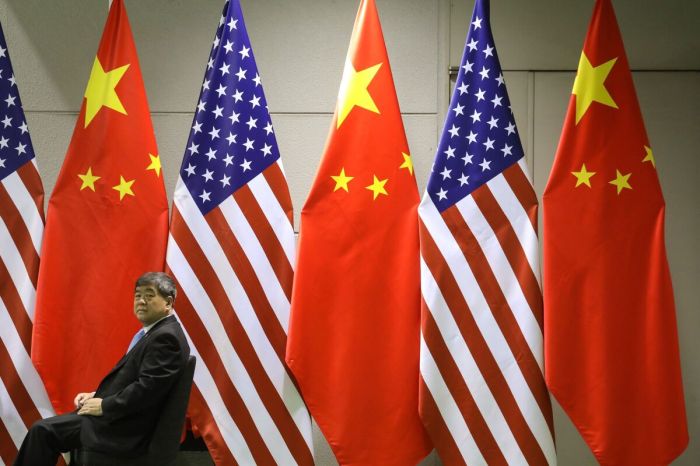
How Trump and Xi can stop trade war? This is a complex issue, but a crucial one. The escalating trade tensions between the US and China have significant global consequences. Understanding the historical context, potential points of agreement, and negotiation strategies is key to finding a resolution.
This post will delve into the historical context of the trade disputes, identifying potential points of agreement, exploring negotiation strategies, and analyzing the potential impact of trade agreements. We’ll also examine the role of international organizations and alternative dispute resolution mechanisms, alongside the crucial aspect of public opinion and domestic politics in shaping these negotiations.
Historical Context of Trade Tensions
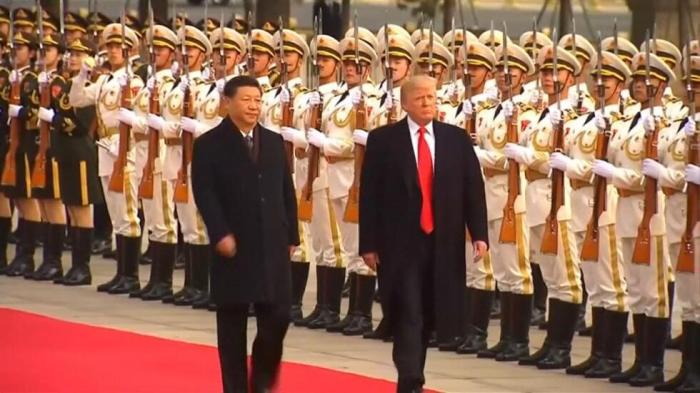
The US-China trade relationship, a cornerstone of global commerce, has been fraught with periods of tension and conflict. From accusations of unfair trade practices to disputes over intellectual property, the two nations have engaged in a complex and often volatile dance of economic maneuvering. Understanding the historical context of these disputes is crucial to appreciating the current trade war and the potential paths towards resolution.The evolution of these trade tensions reveals a pattern of escalating economic and political competition, driven by differing national interests and strategies.
Trump and Xi could potentially halt the trade war by focusing on areas of mutual economic benefit, like joint ventures in emerging technologies. This could involve navigating the complexities of trump tariffs, AI, automation, and robots in a way that fosters collaboration rather than conflict. Ultimately, a negotiated agreement addressing these issues would pave the way for a more stable trading relationship.
This historical analysis highlights the challenges in maintaining a stable and mutually beneficial trade relationship between two powerful global players.
Timeline of Trade Disputes
A detailed examination of the key events and escalating factors in the US-China trade disputes reveals a pattern of increasing friction. This timeline highlights the complex interplay of economic and political motivations that have fueled the trade war.
| Date | Event | US Action | Chinese Response | Impact |
|---|---|---|---|---|
| 2018 | Imposition of tariffs on Chinese goods | The US initiated tariffs on a range of Chinese imports, citing concerns about intellectual property theft and forced technology transfer. | China retaliated with tariffs on US goods, including agricultural products and manufactured goods. | Global markets experienced volatility, and supply chains were disrupted. US farmers suffered significant economic losses, while Chinese consumers faced higher prices. |
| 2019 | Escalation of tariffs and trade negotiations | The US and China engaged in several rounds of trade negotiations, aiming to reduce tariffs and address outstanding issues. | China engaged in countermeasures, maintaining pressure on US industries. | Negotiations yielded limited results, with both sides maintaining their positions. Uncertainty persisted in the global economy. |
| 2020 | Impact of the COVID-19 pandemic | The pandemic disrupted global supply chains, influencing the trade dynamics. | China’s handling of the pandemic and subsequent economic recovery strategies influenced trade. | Supply chain vulnerabilities were exposed, and the pandemic further complicated trade negotiations. |
| 2023 | Recent developments in the trade war | Current US trade policy continues to evolve, adapting to changing geopolitical and economic landscapes. | China’s response to these changes is a dynamic aspect of the ongoing trade war. | The evolving nature of trade tensions and negotiations are likely to have implications for global economic trends. |
Economic and Political Motivations
The US and China have pursued their respective trade policies based on complex economic and political calculations. Understanding these motivations provides insight into the underlying causes of the trade war.
- The US has often cited concerns about intellectual property theft and forced technology transfer as justifications for trade actions. This reflects a desire to protect American industries and innovation.
- China, on the other hand, has sought to maintain economic growth and development, often prioritizing domestic industries and employment. This often involves state support for national champions and strategies for self-reliance.
Evolution of Trade Policies and Strategies
Trade policies employed by both countries have adapted to changing circumstances and economic conditions.
- The US has shifted its approach from unilateral tariffs to a mix of negotiations and other strategies.
- China has employed various measures to mitigate the impact of US tariffs and maintain economic growth.
Previous Attempts at Resolving Trade Disputes
Numerous attempts have been made to resolve trade disputes between the US and China, with varying degrees of success. Past experiences offer valuable lessons for navigating future negotiations.
- Past negotiations have often fallen short of achieving comprehensive resolutions, reflecting the fundamental differences in interests and approaches.
Identifying Potential Points of Agreement
The escalating US-China trade war has created significant economic uncertainty. Finding common ground is crucial for mitigating these risks and restoring stability to global markets. Both nations have significant interests at stake, but shared interests and areas of mutual benefit exist. Exploring potential points of agreement is a crucial step toward a resolution.Identifying areas of mutual interest, acknowledging potential compromises, and understanding the key interests of both nations are essential for navigating this complex situation.
Successful bilateral agreements between the US and China in the past demonstrate the possibility of collaboration despite differing priorities. Analyzing these past successes, and potential concessions, can inform a path toward a mutually beneficial outcome.
Potential Common Ground in Resolving Trade Disputes
The US and China share a desire for a stable and predictable global trading environment. While differing perspectives on specific trade practices persist, both nations stand to gain from a reduction in trade tensions. Shared interests in global economic stability and preventing further escalation of the conflict could serve as a basis for negotiation.
- Market Access: Both countries benefit from access to each other’s markets. Negotiations could focus on removing or reducing tariffs on specific goods, potentially opening up new opportunities for trade. This could lead to increased exports for both nations and boost economic growth.
- Intellectual Property Protection: Both countries recognize the importance of intellectual property rights. Discussions focused on strengthening intellectual property protections in China could address US concerns while benefiting Chinese innovation. This could involve collaborative efforts to improve enforcement and transparency.
- Technology Transfer: The US and China could find common ground by establishing clear and enforceable rules governing technology transfer. This could be beneficial for both sides, addressing concerns about unfair practices while encouraging innovation and competition.
Examples of Successful Bilateral Agreements
Previous agreements between the US and China offer valuable insights into possible compromises.
- Climate Change Cooperation: Joint efforts to combat climate change, like the Paris Agreement, highlight the capacity for cooperation even on sensitive issues. These efforts demonstrate a shared commitment to global environmental sustainability and could serve as a model for trade negotiations.
- Drug Development Agreements: Collaborative efforts in specific areas like pharmaceutical development illustrate a capacity for productive dialogue and mutual benefit. These agreements, while limited in scope, demonstrate the potential for successful bilateral agreements, which could be applied to trade disputes.
Potential Compromises and Concessions
Compromises and concessions are essential for achieving a mutually beneficial outcome.
- Tariff Reductions: The US could reduce tariffs on certain Chinese goods, potentially in exchange for concessions from China in other areas. This approach could incentivize further negotiations and create a more balanced trade relationship.
- Changes in Intellectual Property Practices: China could commit to stricter enforcement of intellectual property rights in exchange for reduced tariffs on specific products. This could provide an incentive for China to address US concerns while securing trade advantages.
Comparative Analysis of Key Interests
| Interest | US | China |
|---|---|---|
| Market Access | Reduced trade barriers to allow for increased exports. | Access to US markets for Chinese goods. |
| Intellectual Property Protection | Strengthening protection of US intellectual property in China. | Increased protection of Chinese intellectual property in the US. |
| Technology Transfer | Clearer and more enforceable rules on technology transfer. | Access to advanced technologies from US companies. |
| Economic Growth | Boosting US manufacturing and consumer goods sectors. | Sustaining economic growth and job creation. |
Exploring Negotiation Strategies
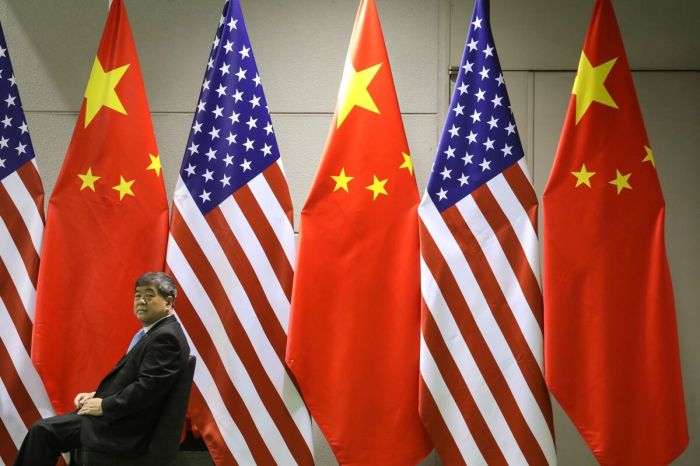
Navigating trade disputes requires nuanced strategies beyond simple tit-for-tat tactics. Effective negotiation hinges on understanding the motivations and priorities of all parties involved, not just the immediate demands. This exploration delves into diverse approaches to conflict resolution and diplomacy, drawing on historical precedents and examining various negotiating styles. A successful strategy needs to account for the complexities of the relationship between the involved parties, acknowledging that their interests extend beyond the immediate trade issues.Understanding the interplay between economic incentives and political considerations is crucial in designing a successful negotiation strategy.
Effective strategies are not one-size-fits-all, demanding careful consideration of the specific context of the trade war and the personalities involved. The success of any negotiation hinges on adaptability and a willingness to compromise.
Understanding Different Negotiation Styles
Different negotiating styles can yield varying outcomes. Understanding these styles is crucial for anticipating the likely responses and tailoring a strategy for success. Competitive negotiation, focused on maximizing one’s own gains, often leads to protracted disputes. Cooperative negotiation, prioritizing mutual benefit, has a higher likelihood of achieving lasting solutions. Understanding the specific style of the negotiators involved, particularly their personal and cultural backgrounds, is key to adjusting tactics.
Examples of Successful Negotiation Strategies
Several historical precedents demonstrate effective negotiation strategies in de-escalating trade tensions. The North American Free Trade Agreement (NAFTA) negotiations, though complex, involved compromise and concession to reach a mutually beneficial agreement. Similarly, the resolution of the Iran nuclear deal highlights the importance of diplomacy and finding common ground. These instances demonstrate that finding common interests, even amidst conflicting demands, can pave the way for a successful outcome.
Figuring out how Trump and Xi can end the trade war might seem like a complex puzzle, but perhaps a little introspection, like in the insightful one to one John and Yoko documentary , could offer some clues. Maybe finding common ground, understanding different perspectives, and a willingness to compromise, are key ingredients. Ultimately, clear communication and a shared desire for resolution are crucial for both sides to move forward.
Potential Negotiation Stages
A potential negotiation process can be Artikeld in a structured approach, emphasizing the importance of clearly defined stages.
- Preparation and Assessment: This stage involves a deep dive into the current trade war dynamics, analyzing the historical context, identifying potential points of agreement, and understanding the motivations of both the US and Chinese leaders. This stage requires a comprehensive understanding of the economic and political landscape. A meticulous review of past negotiations and their outcomes is also essential.
- Initial Contact and Communication: Direct communication channels are established, and initial discussions are held to set the tone and establish boundaries for future negotiations. This phase necessitates a careful approach, prioritizing building trust and demonstrating a willingness to engage constructively.
- Identifying Common Ground: The process focuses on pinpointing shared interests and potential areas of compromise. This phase requires creativity and flexibility, encouraging both sides to explore solutions that satisfy their underlying needs.
- Negotiating Specific Terms: Detailed discussions commence, focusing on the specifics of trade agreements. This stage requires a clear understanding of the issues, and the ability to articulate concessions in a way that preserves core interests. Thorough preparation and clear communication are vital.
- Agreement and Implementation: Formal agreements are reached, and implementation plans are established. This phase involves clear and concise documentation of the terms, timelines, and responsibilities of both sides.
Flowchart of a Potential Negotiation Process
[A visual flowchart depicting the steps Artikeld above would be helpful here. A flowchart would include boxes representing each stage, arrows indicating the progression, and brief descriptions within each box. For example, the first box might be labeled “Preparation and Assessment” and include details on gathering data and analyzing historical context.]
Potential Impact of Trade Agreements
A trade deal between the US and China, resolving the ongoing trade war, could have profound economic consequences for both nations. The potential benefits and drawbacks of such an agreement are multifaceted and impact various sectors, from agriculture to technology. The outcome hinges on the specific terms of the deal, including tariffs, market access, and intellectual property protection.A successful trade agreement would likely bring about a shift in the global economic landscape.
The implications extend beyond bilateral relations, influencing supply chains and international trade practices. Understanding the potential effects on industries, employment, and consumer prices is critical to assessing the long-term ramifications of a trade resolution.
Economic Impacts on the US
A trade deal could boost US exports to China, creating jobs in export-oriented industries. Reduced tariffs on American goods could also lower consumer prices for some products. However, certain domestic industries, particularly those competing with Chinese imports, might face job losses and decreased profitability. The overall impact on US economic growth depends on the extent of market access gained and the specific terms of the agreement.
Economic Impacts on China
A trade deal favorable to China could lead to increased foreign investment and expanded access to the US market for Chinese goods. This could stimulate economic growth and create jobs in various sectors. However, Chinese industries heavily reliant on exporting to the US might experience reduced profits or even restructuring. The magnitude of these effects will depend on the concessions made by both sides and the overall terms of the agreement.
Effects on Industries
The impact of a trade deal varies significantly across industries. For example, agricultural exports to China could experience a surge, while US manufacturing industries competing with Chinese imports might face challenges. A trade deal could foster opportunities for innovation in sectors like high-tech, where US companies currently have a competitive edge. Conversely, Chinese industries like consumer electronics and textiles could gain significant market share in the US.
Employment Impacts
The potential for job creation and loss is significant in both countries. A trade deal could lead to job growth in export-oriented industries in both the US and China. Conversely, import-competing industries might experience job losses. The net impact on employment depends on the specifics of the agreement and the ability of affected industries to adapt to the new market conditions.
Consumer Price Impacts, How trump and xi can stop trade war
A trade deal that reduces tariffs could potentially lower consumer prices for certain goods imported from China. This would be a positive impact for consumers. Conversely, reduced tariffs on Chinese imports might increase competition in some sectors, leading to lower prices, but also potentially negatively affecting some US producers. The impact on consumer prices depends on the specific terms of the deal.
Impact on Global Supply Chains
A trade deal between the US and China could influence global supply chains, shifting production locations and altering international trade patterns. This could lead to changes in the distribution of goods and services globally. The overall impact on global supply chains hinges on the specific provisions of the agreement and the reactions of other countries.
Consequences of Continuing the Trade War
Prolonged trade tensions could harm both countries’ economies. Reduced trade volumes and increased uncertainty could lead to decreased investment and lower economic growth. Furthermore, it could negatively impact global supply chains and international relations. There’s a significant risk of retaliatory actions from other countries.
Data Table: Potential Impacts of Trade Deal
| Industry | Potential Gains/Losses for the US | Potential Gains/Losses for China | Global Impact |
|---|---|---|---|
| Agriculture | Increased exports, potentially lower consumer prices for certain products | Increased access to US agricultural markets | Positive impact on global food security, potentially altering agricultural trade patterns |
| Manufacturing | Potential job losses in import-competing industries, but potential gains in export-oriented industries | Potential gains in market share for some industries | Potential shifts in global manufacturing hubs |
| Technology | Continued competitive advantage, but potential for increased competition | Potential for greater access to US markets, but potential for intellectual property challenges | Could impact global technological innovation and leadership |
Role of International Organizations
The escalating US-China trade war necessitates a comprehensive understanding of the potential role international organizations can play in de-escalation. These organizations, with established frameworks and procedures, offer a neutral platform for dialogue and conflict resolution, potentially mitigating the harmful effects of trade disputes on global economies. International cooperation, facilitated by these organizations, is crucial in finding common ground and establishing mutually beneficial trade agreements.International organizations like the World Trade Organization (WTO) hold a unique position in mediating trade disputes.
Their established rules-based system, while not always perfect, provides a framework for countries to resolve their differences through dialogue and negotiation. By adhering to agreed-upon principles, nations can potentially avoid resorting to retaliatory tariffs and other harmful measures.
Mediating Trade Disputes
The WTO’s dispute settlement mechanism is a crucial tool in international trade relations. It provides a structured process for member countries to address trade grievances. This process typically involves consultations, panel reports, and, if necessary, appellate review. This formal structure offers a degree of predictability and fairness in resolving trade disputes. However, the process can be lengthy and complex, potentially delaying resolution.
Facilitating Dialogue and Cooperation
International organizations can foster dialogue between the US and China by providing platforms for communication and negotiation. Neutral ground, provided by these organizations, can help break down communication barriers and facilitate a more constructive exchange of ideas. This approach can be more effective than bilateral negotiations, especially when trust between the parties is low. Such forums can also bring together experts and stakeholders from both countries to explore common interests and potential solutions.
Past Instances of Resolution
Numerous past instances demonstrate the effectiveness of international organizations in resolving trade conflicts. The WTO has successfully mediated disputes between various countries regarding tariffs, subsidies, and other trade-related issues. While not always perfectly resolving disputes, the WTO’s framework has proven to be an important component in preventing escalating trade conflicts.
Strengths and Weaknesses of Relying on International Organizations
Relying on international organizations for resolving the US-China trade war offers several advantages. Firstly, it fosters a neutral environment for negotiation. Secondly, it provides a structured framework for resolving disputes. Thirdly, it can encourage a wider range of stakeholders to participate in finding solutions. However, there are also inherent limitations.
International organizations often face limitations in enforcing their rulings, and the process can be slow and cumbersome. The political will of member countries also plays a critical role in the effectiveness of these organizations.
Summary Table of Key Roles of International Bodies
| International Body | Key Role in Trade Disputes |
|---|---|
| World Trade Organization (WTO) | Provides a framework for dispute settlement, facilitating consultations and negotiations. |
| International Monetary Fund (IMF) | Offers financial assistance and advice to member countries, promoting stability in the global financial system. |
| World Bank | Provides financial and technical assistance for development projects, potentially impacting trade-related infrastructure and policies. |
Alternative Dispute Resolution Mechanisms
Navigating trade disputes requires more than just negotiation. Alternative dispute resolution (ADR) mechanisms offer a pathway to resolve disagreements outside of traditional court proceedings, potentially fostering more amicable and sustainable solutions. These methods can be particularly valuable when tensions are high and the need for a neutral, third-party perspective is crucial.ADR methods, when properly employed, can expedite the process, reduce costs, and maintain confidentiality, all of which can be beneficial in the delicate dance of international trade.
Trump and Xi need to find common ground to end the trade war, focusing on mutual benefit. It’s a complex situation, but a simple step could be a reassessment of current policies. Meanwhile, recent administrative errors like the case of the Maryland man being deported to El Salvador, highlighted in this article ( ice administrative error deporting maryland man el salvador ), demonstrates the need for careful consideration in all aspects of international relations.
This should ultimately push both leaders towards a more constructive dialogue to resolve the trade war.
This approach may be especially suitable when the parties involved have long-term economic interests intertwined.
Exploring Arbitration
Arbitration is a form of ADR where a neutral third party (an arbitrator) hears evidence and arguments from both sides and makes a binding decision. This process is often more private than litigation, and the rules of procedure are typically agreed upon in advance by the parties.
- Advantages of Arbitration: Faster resolution than litigation, greater flexibility in procedural rules, potentially lower costs, and confidentiality.
- Disadvantages of Arbitration: The decision is binding, and may not always be perceived as equitable, and may be less transparent than litigation.
Examples of successful arbitration in trade disputes include the resolution of disputes between multinational corporations over intellectual property rights and the settlement of trade disagreements between nations involving import quotas or tariffs.
Utilizing Mediation
Mediation involves a neutral third party (a mediator) who facilitates communication and negotiation between the disputing parties. The mediator helps the parties identify common ground and develop mutually acceptable solutions.
- Advantages of Mediation: Preserves relationships, allows for creative solutions, and often leads to more sustainable outcomes.
- Disadvantages of Mediation: It may not always lead to a resolution, and the process can be time-consuming if the parties are unwilling to cooperate.
Successful mediation examples include resolving labor disputes in the manufacturing sector, and the settlement of disagreements between companies over contracts for the supply of raw materials.
Conciliation
Conciliation combines elements of both arbitration and mediation. A conciliator assists the parties in reaching a settlement, but their recommendations are not binding.
- Advantages of Conciliation: It’s less formal than arbitration, allowing for flexibility and a focus on finding a mutually beneficial solution.
- Disadvantages of Conciliation: The lack of binding decisions might leave one party unsatisfied or hesitant to commit to the agreed-upon terms.
Instances of successful conciliation in trade disputes include instances where nations were attempting to find compromises in trade agreements, often with the assistance of international organizations.
A Graphic Depicting Dispute Resolution Models
Imagine a simple, three-column graphic. The left column would display “Negotiation” and illustrate a scenario where both parties are actively involved in finding a solution through dialogue. The middle column would depict “Arbitration” showcasing a neutral third party making a binding decision based on presented evidence and arguments. The right column would represent “Mediation,” showing a neutral third party guiding the parties toward a mutually agreed-upon solution.
Each column would include a visual representation of the process, with possible outcomes ranging from full agreement to no resolution.
Public Opinion and Domestic Politics
The trade war between the US and China is deeply intertwined with domestic political landscapes. Public sentiment, often shaped by media narratives and economic anxieties, plays a significant role in influencing governmental strategies and negotiating positions. Understanding these domestic pressures is crucial to predicting the trajectory of the conflict and the potential for a resolution. Public perception can sway political leaders toward more aggressive or conciliatory approaches, making the path to a trade deal fraught with complexities.Public opinion in both countries is often polarized, with strong opinions on both sides of the issue.
These differing views can create obstacles in reaching a compromise. The dynamics of domestic politics and the interplay between public sentiment and governmental actions will determine the success of any negotiation efforts.
US Public Opinion on the Trade War
American public opinion regarding the trade war has been a mixed bag. While some segments of the population support President Trump’s “America First” approach, others express concerns about the economic consequences of the trade war on American consumers and businesses. The trade war has demonstrably impacted various sectors, leading to debates about its overall benefits and costs. The imposition of tariffs, for instance, sparked concerns about potential price increases and disruptions in supply chains.
These concerns, along with the impact on various industries, influenced the public’s view on the trade war. Support for the president’s trade policies often fluctuated based on the perceived economic conditions and the perceived success or failure of the strategy.
Chinese Public Opinion on the Trade War
Chinese public opinion regarding the trade war has also been complex. National pride and the desire to defend Chinese interests have played a significant role in shaping public perception. However, the trade war’s economic impact on Chinese businesses and consumers has also generated concern. The potential loss of export markets and the disruption to global supply chains are factors that influenced the public’s perspective.
The government’s response to the trade war, including countermeasures and economic stimulus packages, was closely watched by the public. A common thread among the reactions is the importance of national self-reliance and economic security.
Influence of Domestic Politics on Negotiating Positions
The political landscape in both countries significantly influences their negotiating positions. Politicians in both the US and China face pressure from various interest groups, including businesses, labor unions, and political parties. These pressures can influence the concessions each side is willing to make during negotiations. The need to maintain political support at home can often create inflexibility in negotiating strategies.
For instance, the desire to appear strong and decisive on trade issues can hinder the ability to compromise. The trade war created opportunities for political maneuvering and accusations of economic sabotage, further complicating the negotiation process.
Pressure Points for Both Governments
The need to maintain political support at home, manage economic consequences, and demonstrate a strong stance in international affairs are key pressure points for both governments. The economic consequences of the trade war, including job losses and economic downturns, can put pressure on leaders to find a resolution. The public’s reaction to these economic consequences can directly impact the political standing of leaders and the government’s ability to navigate the trade war.
Historical Examples of Public Opinion Impacting Trade Negotiations
The 1980s trade dispute between the US and Japan provides a useful example. Public opinion in both countries played a significant role in shaping the negotiations, influencing the willingness of governments to compromise. Other examples from previous decades illustrate how public sentiment and domestic political pressures can affect the outcome of trade negotiations. Understanding these historical precedents can provide insights into the complexities of navigating public opinion during trade disputes.
- Political Considerations in Trade Negotiations
- Maintaining political support at home is crucial for both the US and China.
- Public opinion on the trade war significantly impacts the negotiating positions.
- Economic consequences of the trade war exert pressure on leaders to find a resolution.
- Public reactions to economic consequences can affect the political standing of leaders.
- The need to appear strong and decisive can hinder compromise.
Last Recap: How Trump And Xi Can Stop Trade War
In conclusion, resolving the trade war between the US and China requires a multifaceted approach. Understanding the historical context, identifying potential common ground, and employing effective negotiation strategies are essential. The potential impact of trade agreements, the role of international organizations, and alternative dispute resolution mechanisms should also be considered. Ultimately, success hinges on navigating the complex interplay of domestic politics and public opinion in both countries.
